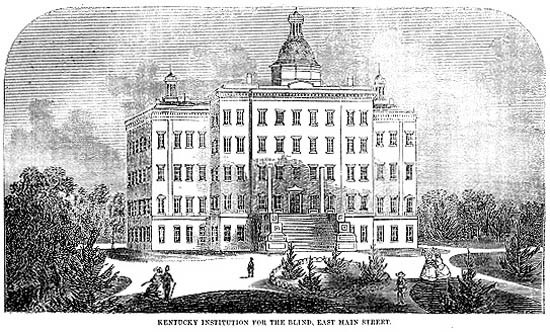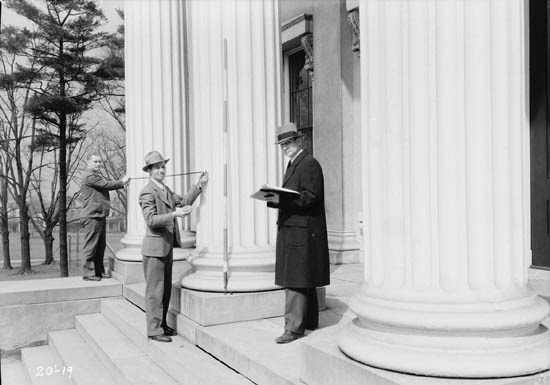
From Louisville: her commercial, manufacturing, and social advantages, 1859.
First Site of the American Printing House for the Blind
Louisville, KY
Designated an NHL: December 21, 1965
Designation withdrawn: Pre-1980*
*A formal dedesignation process was created in 1980. Before then, a property that no longer met NHL criteria was simply removed from the official list.
The efforts of two blind citizens in the mid-1850s helped spur the creation of the American Printing House for the Blind. In 1854, a blind Kentuckian, Morrison Heady, began collecting donations to have Milton's Paradise Lost printed in raised lettering for the blind. Dempsey B. Sherrod, a blind Mississippian, began raising funds in 1856 to establish a national printing house to print books for the blind. Sherrod convinced the state of Mississippi to issue a charter for such a printing house in 1857, to be located in Louisville, Kentucky. The next year, the Kentucky legislature passed an act to establish the American Printing House for the Blind.
In 1860, the printing house received a total of two thousand dollars in donations from private citizens in Mississippi and Kentucky. A printing press was ordered and the American Printing House was established in the basement of the main building at the Kentucky Institution for the Education of the Blind. The Civil War brought the printing house operations to a standstill, but in 1865, the state of Kentucky allocated money for the printing house, and individual donations came from Ohio, Indiana, Kentucky, and Illinois. The Kentucky legislature also started a fund in this year to support the printing house, annually appropriating five dollars for each blind citizen of the state.

HABS Photos
The American Printing House published its first book, Fables and Tales for Children, in 1866. In 1879, the printing house received federal support and recognition; the U.S. Congress passed the "Act to Promote the Education of the Blind." This act funded the production of books for the blind and named the American Printing House as the central national source for these materials. With its national status, production soon outgrew the basement of the Kentucky Institution for the Blind. The state fund started in 1865 paid for construction of a new building for the Printing House, adjacent to the Institute. This building was designed by architect Charles J. Clarke and was finished in 1883. The American Printing House for the Blind continues operating from this building today, although the late nineteenth century building has been enveloped by later additions.
The main building of the Kentucky Institution, where the American Printing House had its start, was constructed in the mid-1850s. The Kentucky Institution for the Education of the Blind was chartered by the Kentucky legislature in 1842; it followed the establishment of schools specifically for the blind in Massachusetts in 1829 and in New York in 1831. Construction of a permanent home for the Institution proceeded from 1852 to 1855; this building was a five story structure in the Greek Revival style, with an entrance portico and three domes surmounted by cupolas. Two four-story wings were added to the building in 1898.

HABS Photos
The design of this building has been traditionally attributed to Francis Costigan, a well-known architect of Madison, Indiana. In fact, an Institute Board of Visitors report from 1854 mentions that "F. Costigan, Esq., an architect of great experience, refined taste and rare ability" had been aiding in construction and had prepared "working plans." Other evidence, however, appears to indicate that Elias E. Williams, a Louisville architect, designed the building. A payment is recorded in Institute records on Jan. 8, 1852 to E.E. Williams for drawing plans and elevations for the Kentucky Blind Institute, as well as for preparing a written description and estimate for the building. In addition, a newspaper article of August 6, 1852 reports that the Kentucky governor had approved the plan of E. Williams, architect for the Kentucky School for the Blind.
The Institute Superintendent, Bryce M. Patten, may have also had a hand in the design. The 1854 Board of Visitors report states: "In the year 1851, Mr. B.M. Patten . . .was requested by a committee of the Legislature, then in session, to lay before them plans of such a building as he deemed desirable for the school for the blind. He therefore immediately drew plans and presented them to the committee, who, after an examination of the same, recommended to the general Assembly the passage of a most liberal act, providing for the erection of all the buildings necessary for the Institution." It appears, therefore, that EE Williams was the architect of the building, but that Costigan and Patten had some part in the design and construction.

HABS Photo
This, the main building of the Kentucky School for the Blind, was documented by the Historic American Buildings Survey in the 1930s. In recognition of its importance in the history of US education, as the First Site of the American Printing House for the Blind, the building was declared eligible for National Historic Landmark status in 1965. It was razed in 1967, however, for construction of a modern building more suited to the needs of the school. The cupola from the main dome of the building was preserved and exhibited on the state capitol grounds at Frankfort; in 1999, this artifact was returned to the school grounds in Louisville.
Last updated: August 29, 2018
